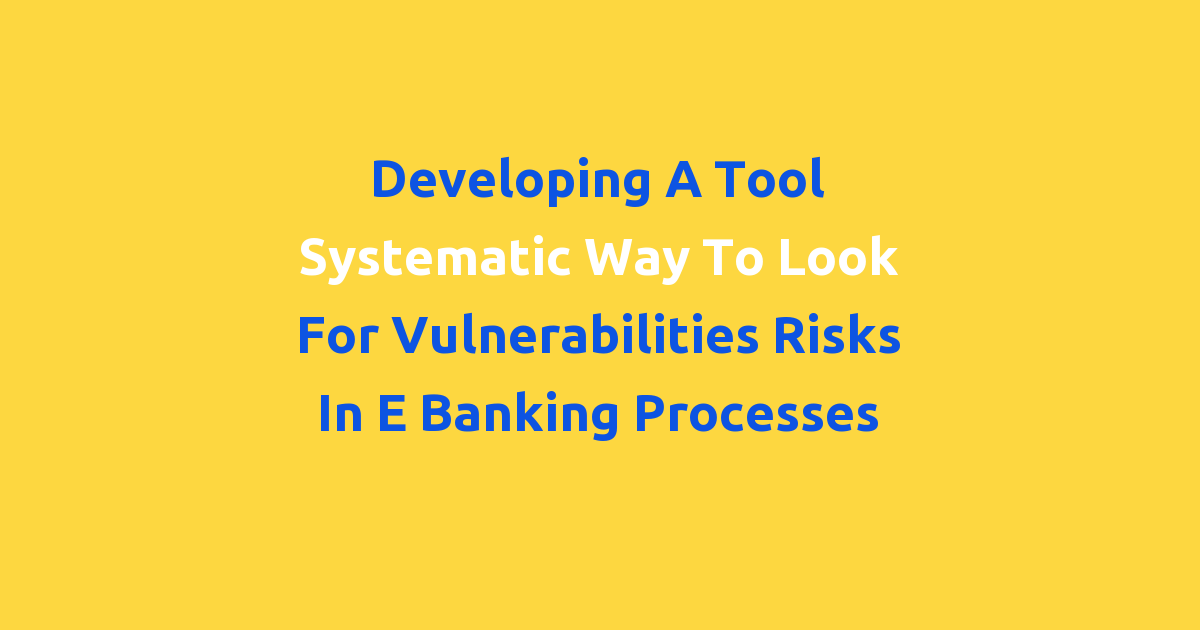Creating a methodical approach for identifying potential vulnerabilities and risks within e-banking processes.
Introduction
With the rapid digitization of banking operations, e-banking has become an integral part of our daily lives. However, with this convenience comes the risk of cyber threats and vulnerabilities that could compromise the security of our personal and financial information. In order to address this growing concern, it is essential to develop a systematic tool that can effectively identify and mitigate these risks in e-banking processes.
Problem Statement
The rise of cyber attacks and data breaches in the e-banking sector has highlighted the need for a robust system that can proactively detect vulnerabilities and risks in the system. The current manual methods of conducting security assessments are time-consuming, inefficient, and often overlook critical points of weakness. This poses a significant threat to the security and trust of e-banking users.
Existing System
The existing system for identifying vulnerabilities in e-banking processes relies heavily on manual security assessments conducted by IT professionals. These assessments involve scanning for vulnerabilities, analyzing security logs, and conducting penetration testing to identify weaknesses in the system. While these methods are effective to some extent, they are not foolproof and are often reactive in nature, leaving e-banking systems vulnerable to new and evolving cyber threats.
Disadvantages
Some of the disadvantages of the current system for identifying vulnerabilities in e-banking processes include:
- Lack of automation leading to delays in identifying and addressing security risks
- Inability to keep up with evolving cyber threats and vulnerabilities
- Inefficient use of resources and time due to manual security assessments
- Risk of overlooking critical vulnerabilities that could be exploited by cyber attackers
Proposed System
The proposed system aims to address these shortcomings by developing a systematic tool that can automatically scan, detect, and prioritize vulnerabilities in e-banking processes. This tool will utilize advanced algorithms and machine learning techniques to continuously monitor the system for potential security risks and provide real-time alerts to IT professionals.
Advantages
Some of the key advantages of the proposed system include:
- Automation of security assessments leading to faster detection and mitigation of vulnerabilities
- Proactive monitoring of the system for new and emerging cyber threats
- Efficient use of resources and time through automated vulnerability scanning
- Enhanced security posture of e-banking systems through continuous monitoring and alerting
Features
The proposed tool for identifying vulnerabilities in e-banking processes will include the following features:
- Automated vulnerability scanning and detection
- Real-time alerts and notifications for IT professionals
- Prioritization of vulnerabilities based on severity and impact
- Integration with existing security systems for seamless monitoring
Conclusion
In conclusion, the development of a systematic tool for identifying vulnerabilities in e-banking processes is essential in order to protect the integrity and security of e-banking systems. By leveraging advanced technologies and automation, we can proactively detect and mitigate security risks, ensuring a safe and secure environment for e-banking users. It is imperative that financial institutions prioritize the development and implementation of such tools to stay ahead of cyber threats and safeguard the trust of their customers.

